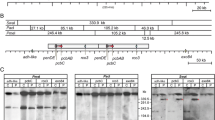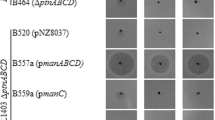Abstract
Putative penicillin-binding proteins (PBPs) were identified in the genome of the Burkholderia cenocepacia strain J2315 based on homology to E. coli PBPs. The three sequences identified as homologs of E. coli PBP1a, BCAL2021, BCAL0274, and BCAM2632, were cloned and expressed as His6-tagged fusion proteins in E. coli. The fusion proteins were isolated and shown to bind β-lactams, indicating these putative PBPs have penicillin-binding activity.


Similar content being viewed by others
References
Ausubel F, Brent R, Kingston RE, Moore DD, Seidman JG, Smith JA et al (1987) Current protocols in molecular biology. Wiley, New York
CFF Burkholderia cepacia Research Laboratory and Repository, University of Michigan Health System, Ann Arbor, MI
Clamp M, Cuff J, Searle SM, Barton GJ (2004) The Jalview Java alignment editor. Bioinformatics 3:426–427
Cserzo M, Wallin E, Simon I, von Heijne G, Elofsson A (1997) Prediction of transmembrane alpha-helices in prokaryotic membrane proteins: the dense alignment surface method. Protein Eng 6:673–676
Curtis NAC, Orr D, Ross GW, Boulton MG (1979) Competition of β-lactam antibiotics for the penicillin-binding proteins of Pseudomonas aeruginosa, Enterobacter cloacae, Klebsiella aerogenes, Proteus rettgeri, and Eschericia coli: comparison with antibacterial activity and effects upon bacterial morphology. Antimicrob Agents Chemother 16:325–328
Dargis M, Malouin F (1994) Use of biotinylated beta-lactams and chemiluminescence for study and purification of penicillin-binding proteins in bacteria. Antimicrob Agents Chemother 5:973–980
Fass RJ, Barnishan J (1980) In vitro susceptibilities of nonfermentative gram-negative bacilli other than Pseudomonas aeruginosa to 32 antimicrobial agents. Rev Infect Diseases 2:841–853
Gish W (1996–2004) http://blast.wustl.edu
Goffin C, Ghuysen JM (1998) Multimodular penicillin-binding proteins: an enigmatic family of orthologs and paralogs. Microbiol Mol Biol Rev 4:1079–1093
Govan JR, Brown AR, Jones AM (2007) Evolving epidemiology of Pseudomonas aeruginosa and the Burkholderia cepacia complex in cystic fibrosis lung infection. Future Microbiol 2:153–164
Guglierame P, Pasca MR, De Rossi E, Buroni S, Arrigo P, Manina G, Riccardi G (2006) Efflux pump genes of the resistance-nodulation-division family in Burkholderia cenocepacia genome. BMC Microbiol 6:66
Hancock RE (1998) Resistance mechanisms in Pseudomonas aeruginosa and other nonfermentative gram-negative bacteria. Clin Infect Dis 27:S93–S99
Holden MTG, Seth-Smith HMB, Crossman LC et al (2009) The genome of Burkholderia cenocepacia J2315, an epidemic pathogen of cystic fibrosis patients. J Bacteriol 191(1):261–277
Legaree BA, Daniels K, Weadge JT, Cockburn D, Clarke AJ (2007) Function of penicillin-binding protein 2 in viability and morphology of Pseudomonas aeruginosa. J Antimicrob Chemother 59:411–424
McGowan JE Jr (2006) Resistance in nonfermenting gram-negative bacteria: multidrug resistance to the maximum. Am J Med 119(6A):S29–S36
Nzula S, Vandamme P, Govan JRW (2002) Influence of taxonomic status on the in vitro antimicrobial susceptibility of the Burkholderia cepacia complex. J Antimicrob Chemother 50:265–269
Parr TR Jr, Moore RA, Moore LV, Hancock RE (1987) Role of porins in intrinsic antibiotic resistance of Pseudomonas cepacia. Antimicrob Agents Chemother 1:121–123
Reik R, Spilker T, Lipuma JJ (2005) Distribution of Burkholderia cepacia complex species among isolates recovered from persons with or without cystic fibrosis. J Clin Microbiol 6:2926–2928
Sauvage E, Kerff F, Terrak M, Ayala JA, Charlier P (2008) The penicillin-binding proteins: structure and role in peptidoglycan biosynthesis. FEMS Microbiol Rev 32:234–258
Stothard P (2000) The sequence manipulation suite: JavaScript programs for analyzing and formatting protein and DNA sequences. Biotechniques 28:1102–1104
Thompson JD, Higgins DG, Gibson TJ (1994) CLUSTAL W: improving the sensitivity of progressive multiple sequence alignment through sequence weighting, position-specific gap penalties and weight matrix choice. Nucleic Acids Res 22:4673–4680
Trepanier S, Prince A, Huletsky A (1997) Characterization of the penA and penR genes of Burkholderia cepacia 249 which encode the chromosomal class A penicillinase and its LysR-type transcriptional regulator. Antimicrob Agents Chemother 11:2399–2405
Vandamme P, Holmes B, Coenye T, Goris J, Mahenthiralingam E, LiPuma JJ, Govan JR (2003) Burkholderia cenocepacia sp. nov.—a new twist to an old story. Res Microbiol 2:91–96
Zhang Y, Fechter EJ, Wang T-SA, Barrett D, Walker S, Kahne DE (2007) Synthesis of heptaprenyl-lipid IV to analyze peptidoglycan glycosyltransferases. J Am Chem Soc 129:3080–3081
Acknowledgments
This work was supported by funding from the Denison University Research Foundation and a Camille and Henry Dreyfus Foundation Faculty Start-up Award for KMS.
Author information
Authors and Affiliations
Corresponding author
Electronic supplementary material
Below is the link to the electronic supplementary material.
Rights and permissions
About this article
Cite this article
Specht, K.M., Sheetz, K.H., Alexander, C.M. et al. Expression and Characterization of Penicillin-Binding Proteins in Burkholderia cenocepacia . Curr Microbiol 60, 274–279 (2010). https://doi.org/10.1007/s00284-009-9537-1
Received:
Accepted:
Published:
Issue Date:
DOI: https://doi.org/10.1007/s00284-009-9537-1




